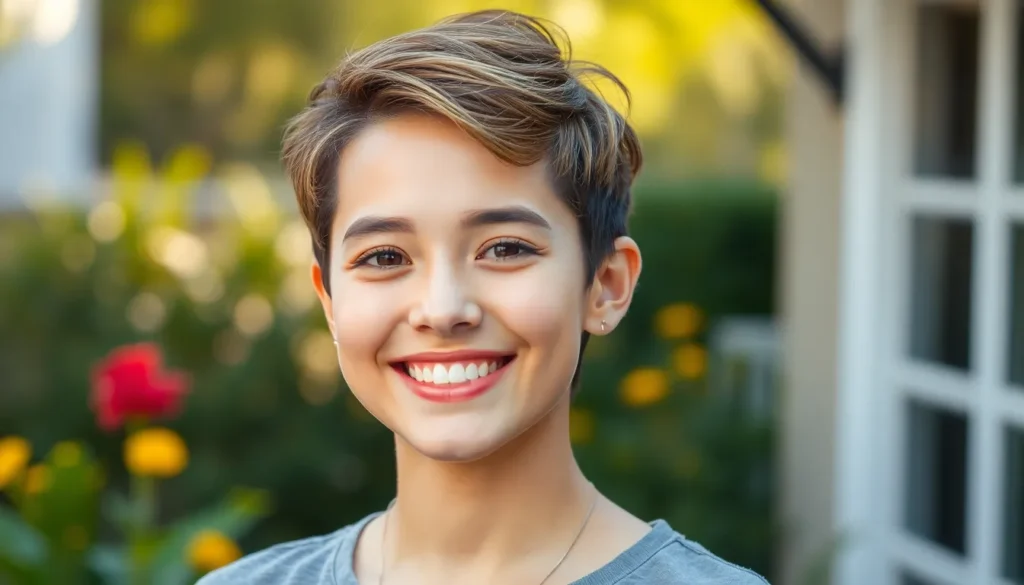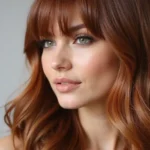We know the struggle of fine hair all too well – it often feels like we’re fighting an uphill battle against flat, lifeless strands that refuse to hold volume or style. But what if we told you that short haircuts could be your secret weapon for creating the illusion of fuller, more ever-changing hair?
Fine hair doesn’t have to mean boring hair. With the right cut and styling techniques, we can transform thin strands into stunning statement pieces that turn heads wherever we go. Short hairstyles are particularly magical for fine hair because they remove excess weight that pulls hair down, instantly creating more body and movement.
We’ve curated fifteen of the most endearing short hairstyles specifically designed to make fine hair look its absolute best. From chic pixie cuts that add instant sophistication to layered bobs that create incredible texture, these styles will revolutionize how you think about your hair’s potential.
Understanding Fine Hair and Why Short Styles Work Best
We’ve discovered that understanding your hair’s unique characteristics makes all the difference when choosing the perfect style. Short cuts naturally complement fine hair’s delicate structure in ways that longer styles simply can’t match.
Characteristics of Fine Hair Texture
Fine hair features individual strands that measure smaller in diameter compared to medium or coarse hair types. Each strand contains less protein and has a thinner cuticle layer, which creates the soft, silky texture many people with fine hair experience.
Weight becomes the primary enemy of fine hair because longer lengths pull strands down and flatten them against the scalp. Volume struggles to develop naturally since fine strands lack the structural thickness needed to create lift and body on their own.
Oil distribution happens faster along fine hair shafts, causing roots to appear greasy within 24 to 48 hours of washing. Static electricity affects fine hair more dramatically because the lightweight strands move easily with air currents and friction.
Benefits of Going Short with Fine Hair
Short styles remove excess weight that drags fine hair down and creates a flat appearance. Layers in shorter cuts add dimension and movement that makes individual strands appear thicker and more substantial.
Volume increases dramatically when we eliminate length because shorter pieces can lift away from the scalp more easily. Styling time decreases significantly with shorter cuts since there’s less hair to work with during your morning routine.
Maintenance becomes more manageable as short styles require less product and fewer tools to achieve polished looks. Damage repair happens faster because we’re constantly trimming away older, more processed ends every 6 to 8 weeks.
Professional styling options expand with shorter cuts as hairstylists can create more dramatic shapes and textures without worrying about weight distribution issues.
Common Styling Challenges to Overcome
Limpness occurs when fine hair lacks natural body and falls flat against the head within hours of styling. Product buildup happens quickly because fine hair can’t support heavy creams, oils, or gels without looking weighed down and greasy.
Breakage increases when we use excessive heat or aggressive brushing techniques on delicate fine strands. Color fading progresses faster in fine hair because the thinner cuticle allows pigment molecules to escape more easily.
Static problems multiply in dry environments as fine hair picks up electrical charges from clothing, brushes, and environmental factors. Root exposure becomes noticeable sooner because fine hair doesn’t provide adequate scalp coverage, especially when it’s parted or styled away from the face.
The Classic Pixie Cut: Timeless and Voluminous

The classic pixie cut remains our go-to recommendation for fine hair because it delivers maximum volume with minimal effort. This iconic style creates the illusion of thicker, fuller hair by removing weight that typically pulls fine strands downward.
Traditional Pixie Styling Tips
Start with volumizing mousse on damp hair to create lift from the roots before blow drying. We recommend applying a golf ball sized amount throughout your hair, focusing on the crown area where fine hair tends to fall flat.
Use a round brush while blow drying to direct hair upward and away from your scalp. The lifting motion creates natural body that lasts throughout the day, giving your pixie cut the dimensional look that fine hair craves.
Apply dry shampoo to clean hair as a preventative styling step rather than waiting for oiliness to appear. This technique adds grip and texture to fine strands, making them easier to style and hold their shape longer.
Finish with a lightweight hairspray held 10 inches away from your head to lock in volume without weighing down your delicate strands. We suggest using a flexible hold formula that maintains movement while providing staying power.
Adding Texture for Extra Body
Layer the cut strategically to create multiple lengths that stack upon each other, giving the appearance of denser hair. Short layers around the crown area lift fine hair away from the scalp, while longer pieces around the ears provide feminine softness.
Request point cutting during your salon visit where your stylist uses the tips of their shears to create uneven, textured ends. This cutting technique removes bulk while adding visual interest that makes fine hair appear fuller and more ever-changing.
Incorporate subtle undercuts in hidden areas like behind the ears or at the nape to reduce excess weight. These strategic cuts allow the top layers to lift more easily while maintaining the classic pixie silhouette.
Use texturizing products with sea salt or clay ingredients that grip fine hair without leaving residue. These formulas create piecey definition that enhances your pixie’s natural movement and prevents the flat appearance that fine hair often exhibits.
The Textured Bob: Modern and Effortlessly Chic

Textured bobs represent the perfect balance between sophistication and modern edge for fine hair. This versatile cut amplifies natural movement while maintaining professional polish.
Creating Movement with Layers
Strategic layering transforms flat fine hair into ever-changing, voluminous styles. We recommend requesting graduated layers that start at the jawline and cascade through the ends. Choppy layers work particularly well because they create natural separation and prevent hair from clumping together.
Point cutting techniques add incredible texture without sacrificing length. Your stylist should use this method to soften blunt edges and create feathered movement throughout your bob. Razored ends deliver even more dramatic texture by varying the lengths of individual strands.
Internal layering boosts volume from within the hair structure. These hidden layers remove bulk while maintaining the bob’s overall shape. We suggest asking for subtle graduation that removes weight from the interior without creating obvious steps in your hairline.
Face framing layers enhance your natural features while adding movement. Longer pieces around your face create flattering angles that draw attention to your best features. These strategic layers also provide styling versatility for both sleek and tousled looks.
Styling Products for Fine Hair Bobs
Volumizing mousses provide lightweight lift without weighing down delicate strands. We apply these products to damp hair from roots to mid lengths before blow drying. Look for alcohol free formulas that won’t dry out your hair or create stiffness.
Texturizing sprays create piecey definition and enhance your bob’s natural movement. These products work best on slightly damp hair and can be reapplied throughout the day for refreshed texture. Salt sprays add beachy waves while clay sprays provide matte separation.
Root lifting powders deliver instant volume at the crown area. Sprinkle these products directly onto clean, dry roots and massage gently with your fingertips. This technique creates long lasting lift without the crunchiness of traditional hairsprays.
Lightweight serums smooth frizz while maintaining your bob’s bouncy texture. Apply these products sparingly to the mid lengths and ends of your hair. Silicone free formulas prevent buildup that can make fine hair appear greasy or flat.
The Asymmetrical Cut: Bold and Contemporary
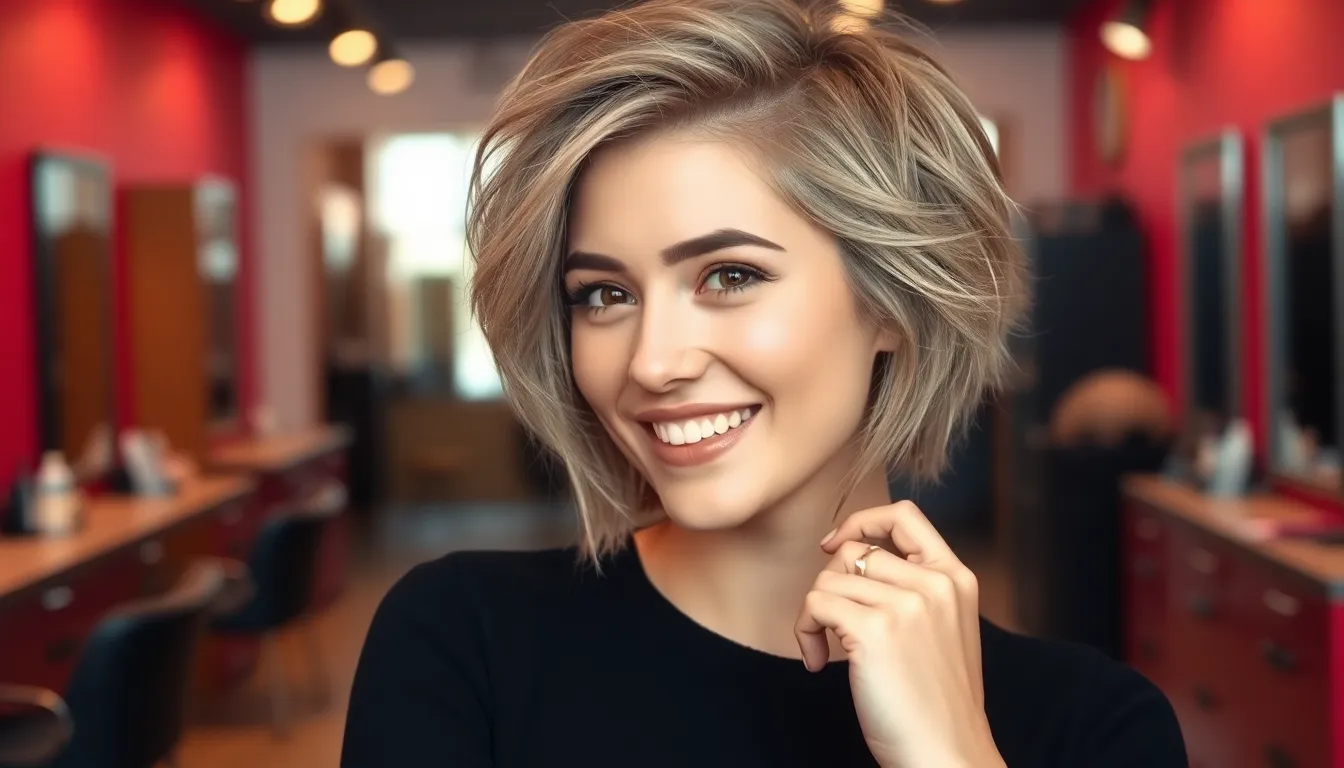
We’ve discovered that asymmetrical cuts offer fine hair an exciting departure from traditional symmetry while creating incredible visual impact. This edgy style transforms thin strands into a statement-making look that commands attention.
Balancing Proportions with Fine Hair
Asymmetrical cuts work exceptionally well for fine hair because they create the illusion of density through strategic length variation. Longer sections on one side naturally fall forward, adding weight and movement that fine hair often lacks. We recommend keeping the shorter side at ear length or above to maintain lift at the roots.
Strategic layering becomes crucial when crafting asymmetrical styles for delicate strands. Internal layers throughout the longer section prevent the hair from appearing flat against the head. Point cutting techniques add texture without removing essential bulk, while subtle graduation creates seamless transitions between lengths.
Face framing elements enhance the overall balance of asymmetrical cuts on fine hair. Wispy side swept bangs complement the longer side beautifully, while shorter pieces around the ears on the cropped side add definition. These details prevent the style from looking unfinished or accidentally uneven.
Color placement amplifies the dimensional effect of asymmetrical cuts significantly. Highlights on the longer side draw attention to the length variation, while subtle lowlights on the shorter side create depth. This contrast makes fine hair appear fuller and more substantial throughout the entire style.
Maintenance Requirements
Regular trims every 4 to 6 weeks keep asymmetrical cuts looking intentional rather than grown out. Fine hair shows length discrepancies more obviously than thicker textures, making consistent maintenance appointments essential. We suggest booking your next appointment before leaving the salon.
Daily styling requires minimal effort once you master the basic technique. Blow dry the shorter side away from your face using a small round brush, then smooth the longer side forward with your fingers. This creates natural movement without excessive manipulation that could damage delicate strands.
Product application needs precision to avoid weighing down fine hair in asymmetrical styles. Apply volumizing mousse only to the roots on both sides, then use a lightweight texturizing spray on the longer section for definition. Avoid heavy creams or oils that could eliminate the style’s natural movement.
Nighttime protection preserves the cut’s shape between styling sessions effectively. Sleep on a silk pillowcase to reduce friction, or loosely clip the longer side away from your face. This prevents the asymmetrical balance from becoming distorted while you rest.
The Layered Shag: Retro-Inspired with Modern Appeal
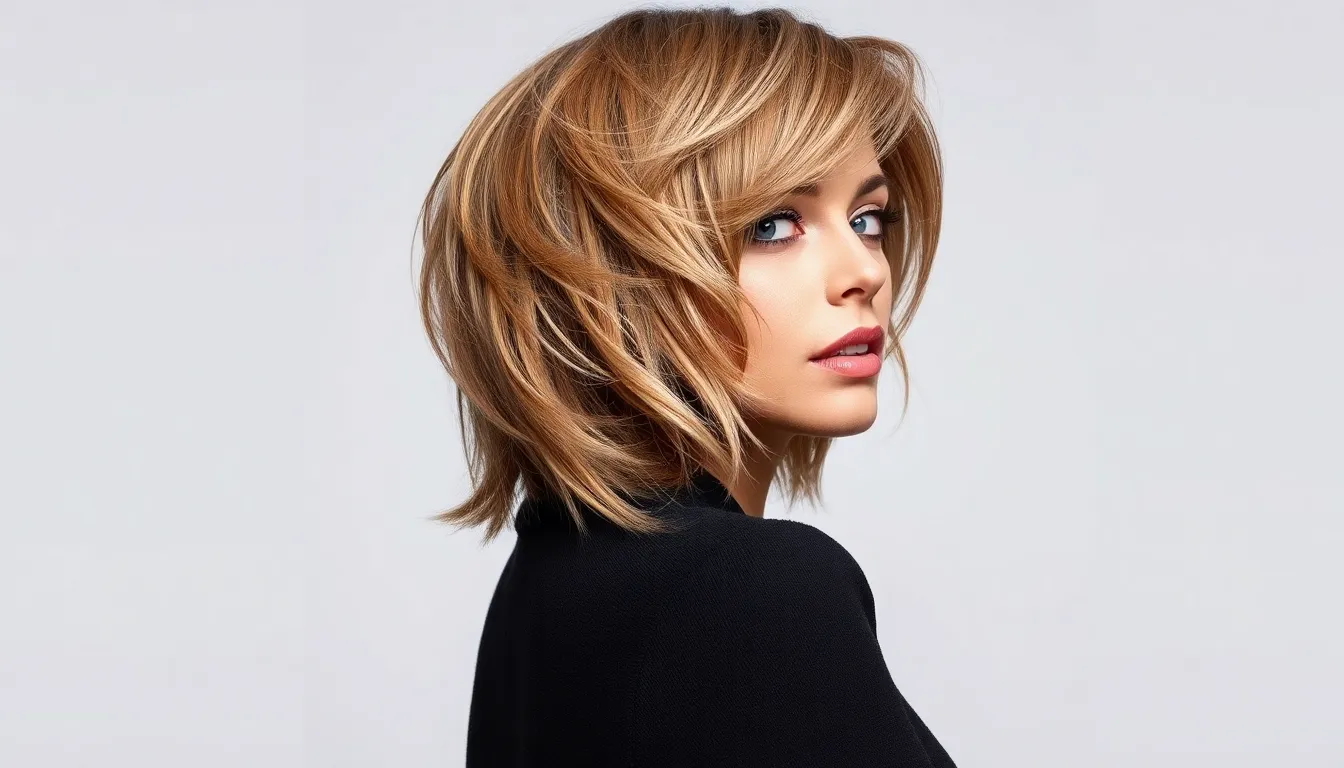
Layered shags bring the perfect fusion of vintage charm and contemporary sophistication to fine hair. This iconic cut delivers exceptional volume and movement through carefully crafted layers that prevent the weight buildup common in longer styles.
Building Volume Through Strategic Layering
Strategic layering transforms fine hair into a voluminous masterpiece by removing bulk in precise locations. We recommend starting with longer layers at the crown to maintain fullness while incorporating shorter pieces throughout the mid-lengths. Choppy layers cut at various angles create natural lift and prevent strands from lying flat against the scalp.
Point cutting techniques work exceptionally well for shag styles on fine hair. This method involves cutting into the hair at angles rather than straight across, creating feathered ends that enhance texture and movement. Internal layering removes weight from within the hair shaft without sacrificing length, allowing fine strands to bounce and move naturally.
Graduation techniques add dimension by creating layers that stack upon each other. We suggest keeping the shortest layers around chin length to frame the face while allowing longer pieces to cascade below. Razor cutting can also enhance the shag’s signature texture by creating softer, more natural-looking ends that blend seamlessly.
Best Face Shapes for Shag Cuts
Round faces benefit tremendously from layered shags that create vertical lines and elongate the silhouette. We recommend keeping layers longer around the sides and incorporating wispy bangs that sweep across the forehead. Side-parted shags with face-framing pieces that hit below the cheekbones help create the illusion of length.
Square faces look stunning with shags that soften angular jawlines through curved layering techniques. Soft, textured bangs paired with layers that begin around the ears help balance strong facial features. We suggest avoiding blunt cuts that emphasize the jawline’s width and instead opting for feathered pieces that create gentle movement.
Oval faces can wear virtually any shag variation with confidence. This face shape allows for experimentation with different bang styles, from full fringe to curtain bangs. We recommend taking advantage of this versatility by choosing layers that enhance your best features, whether that’s highlighting cheekbones or drawing attention to the eyes.
Heart-shaped faces pair beautifully with shags that add width at the jawline through strategic layering. We suggest incorporating fuller layers around the chin area while keeping the crown relatively smooth. Side-swept bangs help balance a wider forehead, while textured pieces around the jaw create the appearance of broader lower facial structure.
The Blunt Bob: Sleek and Sophisticated
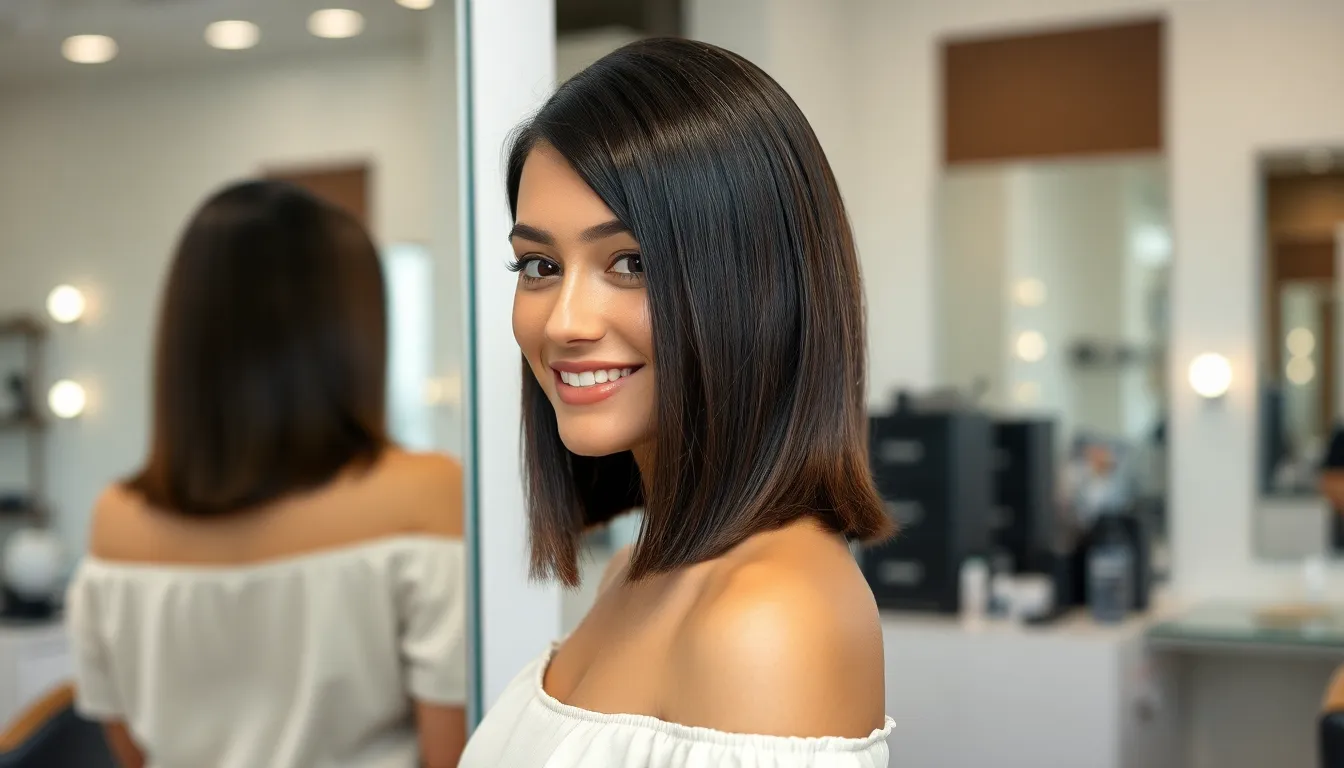
The blunt bob delivers refined elegance while maximizing the appearance of density in fine hair. This timeless cut creates a sharp, geometric line that makes every strand count.
Creating the Illusion of Thickness
Strategic length placement transforms fine hair into a fuller-looking masterpiece. We recommend keeping the length between the chin and shoulders to maintain maximum weight distribution without pulling hair down.
Blunt cutting techniques eliminate wispy ends that reveal hair’s true density. Professional stylists use razor-free methods to create clean, solid lines that appear thicker than layered alternatives.
Internal weight distribution plays a crucial role in achieving volume. We suggest maintaining heavier sections through the middle and crown while keeping the perimeter crisp and even.
Color enhancement amplifies the thickness illusion through strategic placement. Single-process colors in rich, saturated tones create more visual density than multi-dimensional highlights that can expose scalp areas.
Precision maintenance ensures the cut retains its thickness-boosting properties. Regular trims every 6-8 weeks preserve the blunt edge that makes fine hair appear more substantial.
Daily Styling Techniques
Blow-drying fundamentals create the foundation for voluminous blunt bobs. We start with volumizing mousse applied to damp roots then use a paddle brush to smooth hair while directing airflow downward.
Round brush techniques lift sections at the roots during styling. Working with 2-inch sections allows us to create tension that builds body without creating excessive curl or bend in the ends.
Cool shot finishing locks in volume and smoothness simultaneously. This final step seals the hair cuticle and sets the style for longer-lasting results throughout the day.
Product application strategies prevent weighing down fine strands. We apply lightweight serums only to the mid-lengths and ends while keeping volumizing products concentrated at the roots.
Heat protection methods preserve hair health during daily styling. Using thermal protectants before blow-drying and flat ironing prevents damage that can make fine hair appear even thinner over time.
The Side-Swept Pixie: Feminine and Flattering

The side-swept pixie transforms the traditional pixie cut into a softer, more feminine silhouette that works beautifully with fine hair. This elegant variation creates natural movement while maintaining the volume-boosting benefits we’ve discussed throughout our exploration of fine hair answers.
Incorporating Bangs with Fine Hair
Side-swept bangs offer the perfect complement to pixie cuts on fine hair because they add visual weight without creating bulk. We recommend keeping these bangs wispy and textured rather than blunt to prevent overwhelming delicate strands. Point cutting techniques help create natural movement that enhances the overall flow of the style.
Micro bangs work exceptionally well for those seeking a bold statement while maintaining femininity in their pixie cut. These ultra-short fringes create the illusion of density across the forehead area. We suggest positioning them slightly off-center to complement the side-swept direction of the cut.
Feathered edges along the bang line prevent harsh lines that can make fine hair appear thinner. Professional stylists achieve this effect through razor cutting or texturizing shears. The resulting softness creates a seamless transition between the bangs and the longer side-swept sections.
Layered integration ensures bangs blend naturally with the rest of the pixie cut rather than appearing as a separate element. We recommend graduated lengths that flow from shorter pieces at the crown to longer strands that sweep across the forehead. This technique maintains volume while creating natural movement patterns.
Color Techniques to Enhance Volume
Dimensional highlights create the illusion of depth and fullness in side-swept pixie cuts by adding visual texture through strategic color placement. We recommend placing lighter tones along the swept sections to emphasize movement and draw attention to the style’s feminine angles. Babylights work particularly well because they mimic natural sun-kissed variation without overwhelming fine strands.
Root shadowing techniques add instant depth at the scalp level, making hair appear denser from the very foundation. Professional colorists apply darker tones close to the roots and gradually lighten toward the ends. This creates a natural gradient that enhances the swept motion while adding perceived thickness.
Contrast placement along the longer swept sections maximizes visual impact by creating focal points that draw the eye. We suggest incorporating subtle lowlights beneath the surface layers and brighter highlights on top. This layered approach to color creates dimension that makes fine hair appear fuller and more substantial.
Tonal variations within the same color family provide subtle depth without dramatic contrast that might overwhelm delicate hair textures. Warm undertones in browns and cool undertones in blondes create natural-looking dimension. We recommend staying within two shades of the base color to maintain sophistication while improving volume appearance.
The Choppy Lob: Trendy and Texturized

The choppy lob brings together sophisticated length with edgy texture for fine hair transformation. We’ve found this modern twist on the traditional bob creates exceptional volume through strategic irregularity.
Achieving the Perfect Length
Choppy lobs work best when they fall between the chin and collarbone for fine hair types. We recommend positioning the longest pieces at collarbone level to maintain movement without excess weight. Medium layers should hit around the jawline to frame your face naturally.
Point cutting creates the signature choppy texture that makes fine hair appear fuller. Our stylists suggest asking for varied lengths throughout each section rather than uniform cutting. This technique removes bulk while adding visual density through textural contrast.
Internal layering prevents the choppy lob from appearing too heavy at the ends. We layer from the interior outward to build foundation volume before addressing the perimeter. Graduating the layers creates seamless blending while maintaining the choppy aesthetic.
Face shape considerations determine optimal length placement for your choppy lob. Round faces benefit from longer front pieces that extend past the chin. Square faces look best with softer, irregular lengths that break up angular jawlines.
Heat Styling Tips for Fine Hair
Volumizing mousse applied to damp hair creates the foundation for successful heat styling. We distribute product from mid-lengths to ends while avoiding the root area to prevent weighing down fine strands. This preparation step ensures lasting lift and texture.
Round brush blow drying builds essential volume at the roots before adding choppy texture. We recommend using a medium barrel brush to lift sections away from the scalp while directing airflow upward. This technique creates the base fullness needed for choppy styling.
Flat iron techniques enhance the choppy lob’s textured appearance without compromising fine hair health. We suggest using lower heat settings between 300-350°F and working in small sections. Alternating the iron direction creates natural looking irregularity.
Texturizing spray adds grit and separation to emphasize the choppy layers. We apply this product after heat styling to enhance the cut’s dimensional qualities. Light misting prevents product buildup while maximizing textural definition.
Root lifting powder provides extra volume boost when applied before heat styling. We focus application at the crown and part areas where fine hair tends to fall flat. This targeted approach creates lasting lift without affecting the choppy texture below.
The Graduated Bob: Structured and Polished

The graduated bob delivers architectural precision for fine hair while maintaining effortless elegance. This sophisticated cut creates natural volume through strategic length variations that enhance your hair’s inherent texture.
Understanding the Graduated Cut Technique
Graduated cuts use systematic layering where each section becomes progressively shorter as it moves toward the nape. We achieve maximum volume by removing weight from underneath while preserving length on top layers. This technique creates a stacked effect that lifts fine strands away from the scalp naturally.
Stylists employ point cutting and slide cutting methods to prevent harsh lines that can appear too heavy on fine hair. The graduated structure works by creating invisible support layers that hold the outer hair away from your head. We recommend requesting layers that graduate no more than 2-3 inches between sections to maintain a polished appearance.
Length placement typically ranges from chin to shoulder level, with the shortest interior layers falling at the occipital bone. This positioning ensures optimal lift without creating an overly dramatic silhouette. The graduation technique adds approximately 30% more volume compared to traditional one length bobs on fine hair textures.
Professional vs. At-Home Maintenance
Professional maintenance requires appointments every 6-8 weeks to preserve the graduated structure’s integrity. Stylists can precisely trim each layer to maintain the proper weight distribution that prevents fine hair from falling flat. We’ve observed that professional cuts last longer because they account for natural growth patterns and hair density variations.
At home styling involves exact techniques to maximize the graduated bob’s volume potential. Use a round brush during blow drying to lift each layer individually, starting with the shortest sections first. Apply volumizing mousse to damp hair and work through with your fingers before using any heat tools.
Daily maintenance becomes simpler with graduated cuts since the structure naturally falls into place. We recommend using dry shampoo at the roots every other day to maintain texture without weighing down fine strands. Sleep on silk pillowcases to prevent friction that can flatten the graduated layers overnight.
Touch up techniques include using a flat iron to flip the ends of each layer slightly outward, improving the graduated effect. Root lifting powder applied directly to the crown area provides additional height that complements the cut’s natural structure. Avoid heavy conditioning treatments on the roots to prevent compromising the volume that graduation techniques create.
The Wispy Pixie: Soft and Romantic
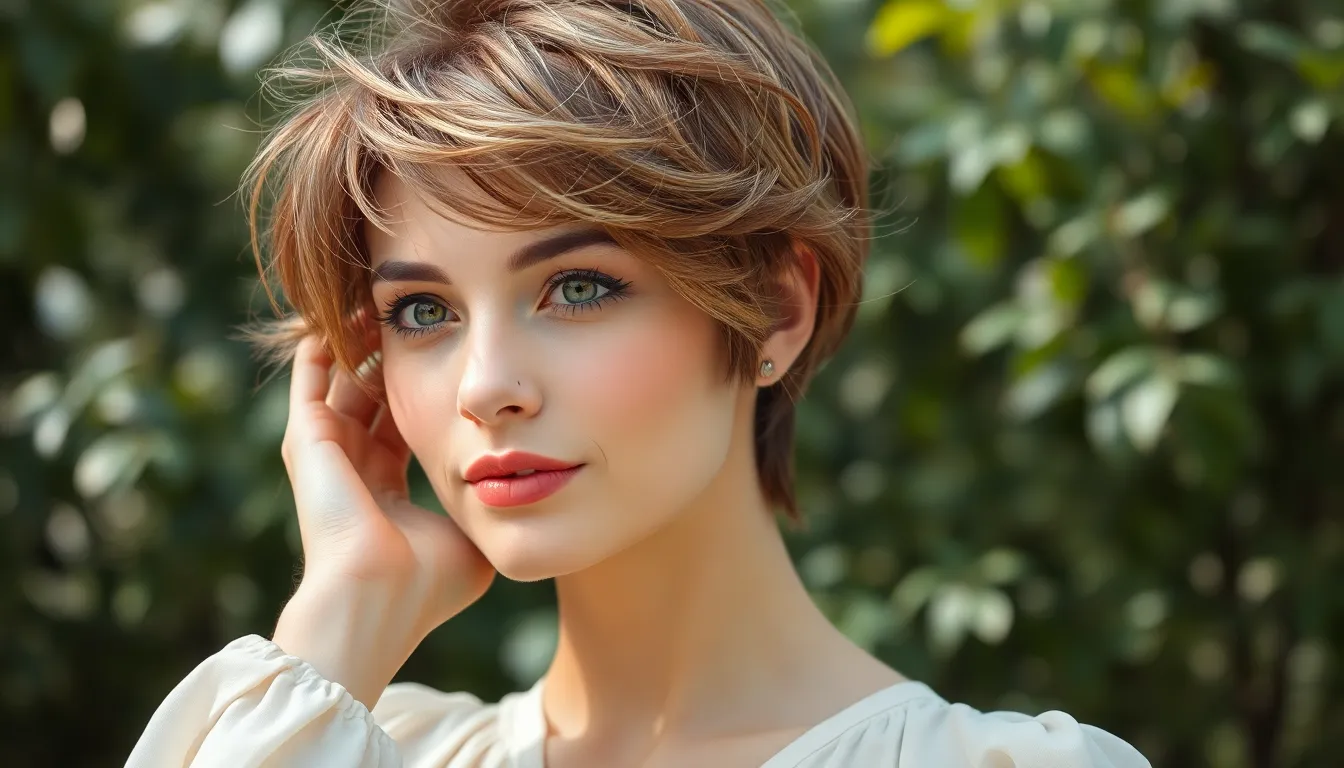
The wispy pixie transforms the traditional sharp pixie cut into something ethereal and feminine through delicate layering techniques. We love how this style creates romantic softness while maintaining the volume benefits that fine hair craves.
Creating Delicate Texture
Point cutting becomes our secret weapon for achieving wispy pixie perfection. This technique involves cutting hair at an angle with the tips of shears rather than straight across. Feathering the ends creates natural movement that prevents fine hair from looking blocky or heavy.
Thinning shears work magic on thicker sections throughout the cut. We recommend using them sparingly on fine hair to avoid creating holes or gaps. Strategic placement around the crown and nape areas adds softness without sacrificing essential volume.
Razor cutting delivers the most natural wispy texture when done correctly. Professional stylists use razors to create seamless blending between layers. This technique removes weight while maintaining length in key areas that frame your face.
Internal layering creates body from within the haircut itself. Cutting shorter pieces underneath longer ones builds natural lift at the roots. These hidden layers support the wispy exterior pieces while adding fullness throughout.
Face framing layers enhance the romantic quality of wispy pixies. Longer pieces around the temples and ears create softness that balances angular facial features. We suggest keeping these pieces long enough to tuck behind your ears when desired.
Products to Avoid Weighing Down Hair
Heavy creams and oils destroy the delicate nature of wispy pixie cuts instantly. These products coat fine strands and eliminate the natural movement we’re trying to achieve. Skip anything labeled as “smoothing” or “anti-frizz” cream for your wispy pixie.
Silicone-based serums create buildup that makes fine hair appear flat and lifeless. While these products promise shine they actually dull the natural luminosity of healthy fine hair. We recommend water-based alternatives that won’t accumulate on your strands.
Leave-in conditioners with heavy formulations weigh down the wispy texture you’ve worked to create. Traditional leave-ins contain moisturizing agents that fine hair simply can’t support. Lightweight spray conditioners work better for maintaining softness without sacrificing volume.
Gel and strong-hold styling products stiffen fine hair and eliminate natural movement. These products make wispy pieces clump together and lose their delicate appearance. Choose flexible-hold mousses or texturizing sprays instead.
Volumizing shampoos with sulfates strip fine hair of essential oils it needs to maintain elasticity. Over-cleansing leads to brittleness and breakage that ruins the soft texture of wispy cuts. Gentle sulfate-free formulas preserve your hair’s natural protective barrier while still providing cleansing power.
The French Bob: Effortlessly Elegant
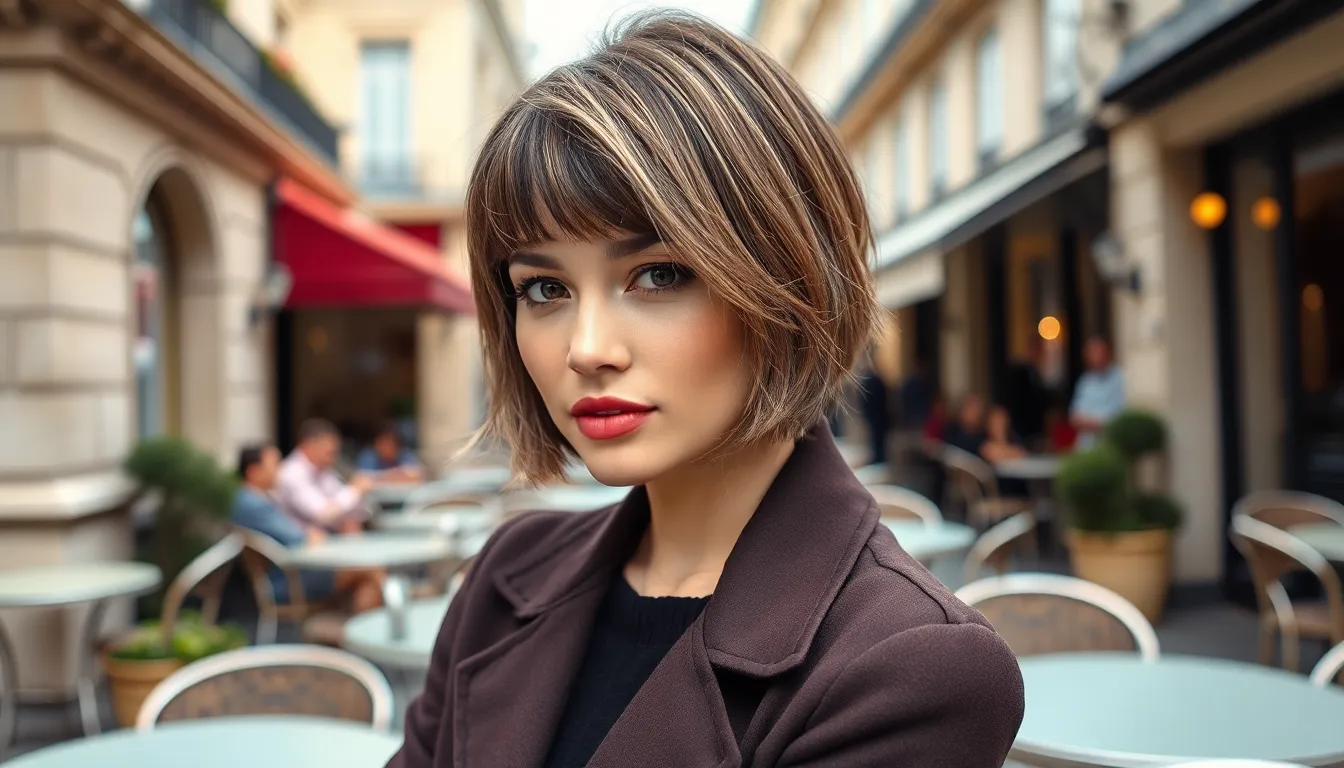
The French bob brings sophisticated charm to fine hair through its precise chin-length cut and subtle internal layering. We’ve found this timeless style creates natural volume while maintaining an air of Parisian chic that complements delicate hair textures perfectly.
Achieving the Parisian Look
Creating an authentic French bob starts with strategic length placement that falls just at the jawline to maximize density appearance. Our preferred cutting technique involves point cutting the ends to prevent bluntness while maintaining weight distribution throughout the style. Internal layering becomes crucial for fine hair as it removes excess weight without sacrificing the bob’s signature fullness.
Texture plays a vital role in capturing that effortless French aesthetic we’re seeking. Professional stylists recommend using razor cutting techniques sparingly around the perimeter to create subtle movement without compromising hair health. Face-framing pieces should be cut slightly shorter to enhance natural bone structure while adding dimensional interest to the overall shape.
Color enhancement amplifies the French bob’s sophisticated appeal through strategic placement of subtle highlights. We suggest choosing tones only one to two shades lighter than your base color to create depth without overwhelming fine strands. Root shadowing techniques can add visual weight at the crown area where fine hair often appears flattest.
Styling for Different Occasions
Daily styling for the French bob requires minimal effort while delivering maximum impact for fine hair. We recommend applying volumizing mousse to damp roots before blow-drying with a round brush to create lift at the crown. Directing airflow downward along the hair shaft helps smooth the cuticle while maintaining body throughout the length.
Professional settings benefit from a sleeker interpretation of the French bob achieved through flat iron techniques. Start with a heat protectant specifically formulated for fine hair to prevent damage during styling. We’ve discovered that running the flat iron through small sections while pulling slightly upward at the roots creates subtle volume without sacrificing the polished appearance.
Evening events call for textured styling that emphasizes the bob’s natural movement and charm. Apply texturizing spray to dry hair before using a curling iron with a 1-inch barrel to create loose waves. We prefer wrapping sections away from the face to enhance the French bob’s flattering qualities while adding romantic softness to fine strands.
Weekend casual styling embraces the French bob’s inherent versatility through air-drying techniques that enhance natural texture. Scrunch hair gently with a microfiber towel while applying sea salt spray to encourage subtle waves. This approach allows fine hair to maintain volume without the weight of heavy styling products that can flatten delicate strands.
The Razor Cut Bob: Edgy and Dynamic

The razor cut bob transforms fine hair into a textured masterpiece that radiates modern sophistication. We’ll explore how this cutting-edge technique creates natural movement and dramatic dimension.
Benefits of Razor Cutting for Fine Hair
Razor cutting removes excess weight while preserving natural texture. The blade creates microscopic variations in each strand length, generating organic movement that makes fine hair appear fuller. We achieve this by slicing through hair at slight angles rather than cutting straight across.
Textural depth increases through the razor’s unique cutting action. Each stroke creates subtle irregularities that catch light differently, producing visual thickness without adding bulk. This technique works particularly well for fine hair because it maintains essential volume while eliminating heaviness.
Movement enhancement occurs naturally with razor cutting methods. The varied strand lengths create internal layers that shift and flow with each head movement. We find this especially beneficial for fine hair that typically lacks natural body and tends to lie flat against the scalp.
Color distribution improves dramatically through razor-created texture. The uneven strand lengths allow highlights and lowlights to blend seamlessly, creating dimensional depth that makes fine hair appear denser. Professional colorists often prefer working with razor cuts because they showcase color placement more effectively.
Styling for Maximum Impact
Start with volumizing mousse applied to damp roots for foundational lift. We recommend using a dime-sized amount focused on the crown area where fine hair typically falls flattest. The mousse creates grip between strands while adding essential body without weight.
Blow dry using a round brush to enhance the razor cut’s natural texture. Pull sections upward while directing heat from roots to ends, allowing the varied lengths to create their characteristic tousled appearance. We suggest using medium heat to prevent damage while achieving maximum volume.
Apply texturizing spray throughout mid-lengths and ends after styling. This enhances the razor cut’s edgy dimension while providing hold that maintains the style’s ever-changing movement. Focus on areas where the cutting technique created the most textural variation.
Scrunch sections gently to activate the razor cut’s inherent texture. The varied strand lengths respond beautifully to this technique, creating natural separation that emphasizes the cut’s edgy appeal. We find this works best when hair is about 80% dry for optimal texture activation.
Finish with lightweight hair oil on the very ends only. This prevents the razor cut edges from appearing too choppy while maintaining the style’s sophisticated edge. Use sparingly to avoid weighing down fine hair’s natural movement and volume.
The Tousled Crop: Casual and Carefree

The tousled crop delivers effortless charm while maximizing volume for fine hair through deliberately imperfect styling techniques. This relaxed approach creates natural movement and texture that fine hair craves without appearing overdone.
Creating Natural-Looking Texture
Scrunching techniques form the foundation of achieving authentic tousled texture in fine hair crops. We apply lightweight texturizing spray to damp hair before gently scrunching upward sections with our palms. This method encourages natural curl patterns while preventing fine strands from becoming weighed down.
Air drying methods enhance the crop’s casual appearance while preserving delicate fine hair structure. We twist small sections around our fingers while hair remains slightly damp, then allow gravity to work its magic. This technique creates subtle waves and bends that appear completely natural.
Product layering strategies build texture without creating heaviness that plagues fine hair. We start with a volumizing mousse at the roots, follow with a sea salt spray through mid lengths, and finish with a lightweight texturizing paste on the ends. Each product serves a exact purpose in creating the perfect tousled effect.
Finger styling approaches replace traditional brush techniques to maintain the crop’s deliberately messy appearance. We run our fingers through sections while hair dries, separating and lifting pieces to create organic movement. This hands on method prevents the polished look that can make fine hair appear flat.
Quick Morning Styling Routines
Five minute refresh methods transform overnight flatness into perfect tousled texture. We spritz dry shampoo at the roots, scrunch sections with our hands, and twist random pieces around our fingers. This quick routine revives the crop’s volume and creates effortless morning style.
Overnight preparation techniques set the stage for easy morning styling with minimal effort. We apply leave in conditioner to damp hair, braid small sections loosely, and secure with soft fabric ties. These gentle waves provide the perfect base for morning tousling.
Heat free styling options protect fine hair while creating lasting texture throughout busy days. We wrap slightly damp sections around foam rollers for 20 minutes, then gently remove and separate with our fingers. This method delivers bounce without damaging delicate fine hair strands.
Touch up strategies maintain the crop’s casual appeal during midday style sessions. We carry a small bottle of texturizing spray and apply sparingly to areas that have fallen flat. Quick scrunching motions restore movement and keep the tousled effect looking fresh all day.
The Micro Bob: Ultra-Modern and Statement-Making

The micro bob pushes boundaries with its dramatically shortened length while creating incredible fullness for fine hair. This cutting-edge style typically hits between the jawline and mid-ear, delivering maximum impact through minimal length.
Working with Very Short Lengths
Short lengths transform fine hair’s natural characteristics into stunning volume advantages. We recommend keeping the longest pieces no longer than jaw level to maintain optimal lift and prevent weight accumulation. Professional stylists achieve the micro bob’s signature density through strategic point cutting techniques that create internal texture without removing essential volume.
Precision becomes crucial when working with such abbreviated lengths. Every half-inch makes a important visual difference, requiring expert placement to balance proportions correctly. The micro bob relies on graduated layers concentrated at the crown and sides to build architectural structure that fine hair naturally supports.
Maintenance schedules intensify with ultra-short styles, typically requiring professional touch-ups every 4-5 weeks. Between appointments, we suggest using volumizing powder at the roots and lightweight texturizing cream through the mid-lengths. These products enhance the micro bob’s natural movement without creating buildup that flattens fine strands.
Styling micro bobs requires different techniques than longer cuts. We recommend using a small round brush during blow-drying to create maximum lift at the crown. Focus the brush’s tension on root areas rather than pulling through to the ends, which preserves the cut’s intentional choppiness and prevents over-smoothing.
Face Shape Considerations
Oval faces benefit most from the micro bob’s dramatic proportions and clean lines. The style’s abbreviated length accentuates natural facial symmetry while the added volume at ear level creates flattering width. We position the shortest layers just above the cheekbone to enhance bone structure without overwhelming delicate features.
Round faces require strategic length placement to avoid emphasizing width. Position the micro bob’s longest pieces slightly below the jawline and incorporate asymmetrical elements to create vertical lines. Internal layering concentrated at the crown adds height that counterbalances facial roundness, while side-swept styling prevents the cut from appearing too blunt.
Square faces gain softness through the micro bob’s textured edges and strategic layering. We recommend incorporating wispy pieces around the temples and softening the perimeter with point cutting techniques. These modifications reduce angular emphasis while maintaining the style’s modern edge and volume-boosting properties.
Heart-shaped faces need careful consideration of the micro bob’s proportions to balance wider foreheads with narrower chins. Extend the length slightly at the sides to create width at jaw level, and incorporate subtle internal layers that add fullness without bulk. This approach ensures the micro bob flatters rather than exaggerates facial proportions.
Long faces can wear micro bobs successfully when stylists add horizontal volume through strategic layering. We focus on creating width at ear level through graduated cutting techniques that build lateral fullness. Avoid excessive height at the crown, instead directing volume outward to create the illusion of broader proportions that complement elongated facial structures.
The Feathered Pixie: Voluminous and Bouncy
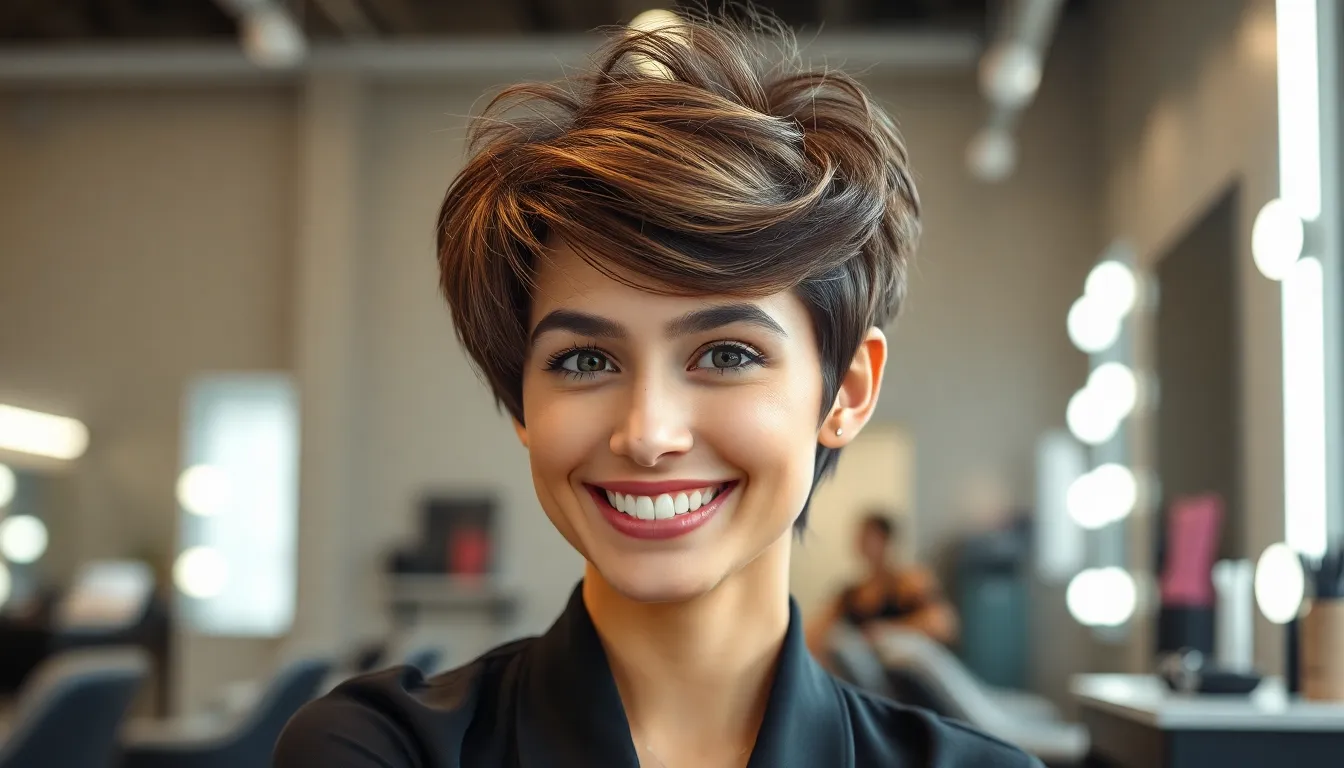
We love how feathered pixies transform fine hair into bouncy masterpieces through strategic layering and movement-improving techniques.
Techniques for Adding Lift
Point cutting creates the foundation for feathered texture while removing excess weight that drags fine strands down. We recommend asking your stylist to use point cutting throughout the crown and sides to establish natural lift patterns.
Layering at different lengths produces the signature feathered effect that fine hair craves. Start with shorter layers at the crown measuring 1-2 inches, gradually lengthening toward the nape to create cascading movement.
Root lifting techniques during the cutting process ensure maximum volume potential. Internal layering removes bulk from underneath while preserving surface density, creating the illusion of thicker hair.
Thinning shear placement requires precision to avoid creating holes in fine hair. We suggest using thinning shears only on the mid-lengths and ends, never at the roots where fine hair needs all available density.
Razor texturizing adds organic movement when applied correctly to feathered pixies. Light razor work on the perimeter creates soft, wispy ends that bounce naturally without appearing choppy.
Crown elevation during cutting establishes the lift foundation that makes feathered pixies so flattering. Cutting sections at 90-degree angles from the scalp creates natural volume that requires minimal styling effort.
Color Placement for Enhanced Dimension
Highlights around the face amplify the feathered texture while creating depth that makes fine hair appear fuller. We recommend placing lighter tones on the shortest layers to catch light and enhance movement.
Root shadowing techniques add visual weight to fine hair without actual bulk. Applying color one shade darker than your natural tone at the roots creates the illusion of density and depth.
Dimensional lowlights throughout the mid-lengths prevent fine hair from appearing flat or one-dimensional. Strategic placement of deeper tones in the longer feathered pieces creates natural-looking fullness.
Color melting between tones ensures seamless transitions that enhance the feathered pixie’s organic movement. Blending highlights and lowlights prevents harsh lines that can make fine hair look stringy.
Glossing treatments every 4-6 weeks maintain color vibrancy while adding protective shine that makes fine hair appear thicker. Clear glosses fill microscopic gaps in fine hair cuticles, creating smoother surfaces that reflect more light.
Balayage application on feathered layers creates sun-kissed dimension that moves naturally with the hair’s texture. Hand-painted highlights follow the hair’s natural fall patterns, improving the feathered effect rather than fighting against it.
Conclusion
We’ve explored fifteen stunning short hairstyles that transform fine hair into voluminous works of art. Each cut offers unique benefits – from the precision of graduated bobs to the carefree charm of tousled crops.
The key lies in choosing techniques that work with your hair’s natural texture rather than against it. Strategic layering point cutting and proper product selection can make all the difference in achieving fuller-looking hair.
Remember that professional maintenance and consistent styling routines will help preserve these cuts’ volume-boosting properties. Whether you’re drawn to edgy razor cuts or romantic wispy pixies there’s a perfect short style waiting to enhance your fine hair’s natural beauty.
Frequently Asked Questions
What makes short haircuts better for fine hair than long styles?
Short haircuts eliminate excess weight that can weigh down fine hair, making it appear limp and flat. By removing this weight, short styles allow for increased lift, movement, and natural volume. They also create the illusion of density and make styling easier with less product buildup.
Why does fine hair appear flat and lifeless?
Fine hair has individual strands that are smaller in diameter and contain less protein, resulting in a soft, silky texture. When fine hair is longer, the weight of the hair pulls it down, making it difficult to achieve volume and causing it to appear flat against the scalp.
Which short hairstyle provides the most volume for fine hair?
The classic pixie cut delivers maximum volume with minimal effort. Its ultra-short length removes all excess weight, allowing for incredible lift at the roots. When styled with volumizing mousse and proper blow-drying techniques, the pixie cut creates the appearance of fuller, thicker hair.
How often should I trim my short hairstyle to maintain volume?
Most short hairstyles for fine hair require professional maintenance every 4-8 weeks. Precision cuts like the micro bob need touch-ups every 4-5 weeks, while styles like the graduated bob can go 6-8 weeks between trims to maintain their volume-boosting structure.
What styling products work best for fine hair?
Use lightweight, volumizing products that won’t weigh down fine hair. Recommended products include volumizing mousse, texturizing sprays, root lifting powders, and lightweight serums. Avoid heavy creams, oils, or products with silicones that can cause buildup and flatten fine hair.
Can I add texture to fine hair without making it look thin?
Yes, through strategic cutting techniques like point cutting, razor cutting, and internal layering. These methods create texture and movement while maintaining fullness. Choppy layers, wispy textures, and feathered effects can add dimension without removing too much density from fine hair.
Which face shapes work best with short hairstyles for fine hair?
Short hairstyles are versatile for most face shapes. Oval faces can wear almost any short style, while round faces benefit from longer pixies or asymmetrical cuts. Square faces look great with soft, curved layers, and heart-shaped faces should choose styles that add width at the jawline.
How do I prevent my fine hair from looking flat after styling?
Use volumizing mousse on damp hair, blow-dry with a round brush lifting at the roots, and finish with texturizing spray or dry shampoo for added grip. Avoid over-conditioning, sleep on silk pillowcases, and consider using root lifting powder for extra lift throughout the day.
What’s the difference between a bob and a lob for fine hair?
A bob typically ends between the jawline and shoulders, while a lob (long bob) extends to the collarbone. For fine hair, shorter bobs often provide more volume, but a well-layered lob can work if it includes strategic internal layering and texturizing techniques to prevent weight from pulling the hair down.
Can color help make fine hair look fuller?
Absolutely. Strategic color placement like highlights, lowlights, and dimensional techniques create the illusion of depth and thickness. Root shadowing adds darkness at the roots for lift, while face-framing highlights draw attention upward. Avoid single-process colors that can make fine hair appear flatter.

